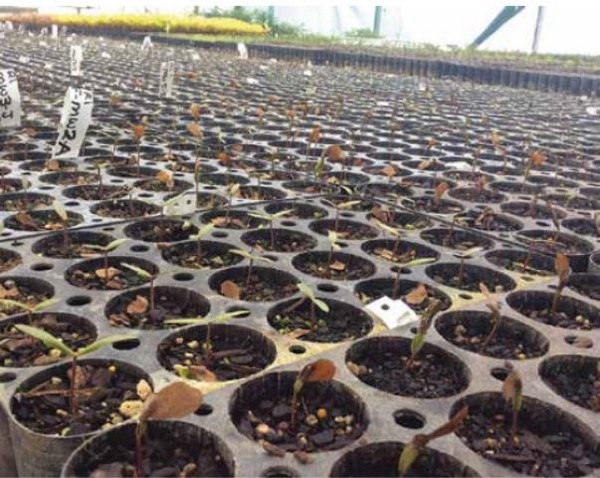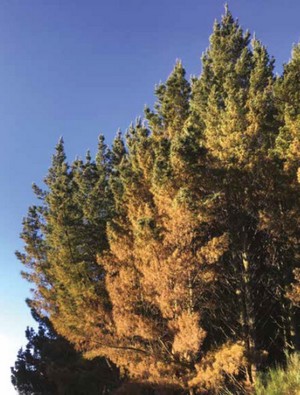Understanding kauri whakapapa in fight against dieback disease
Kauri dieback disease is wreaking havoc on our northern kauri forests, and without intervention, this prolific wasting disease will continue to spread, choking kauri to death from their roots. To date, there are limited options for managing kauri dieback after it has become established and given the slow regeneration time of kauri, this insidious disease is a cause of major concern. Kauri’s best chance for survival long-term is to find kauri plants with inherent resistance to the disease.
Looking for resistant strains of kauri to breed from is a major focus of the Scion-led Healthy Trees, Healthy Future (HTHF) collaborative research programme. Kauri dieback is caused by the soil-borne fungus-like organism Phytophthora agathidicida, and the HTHF programme aims to identify markers and establish screening methods to assess any natural disease resistance.
The team, led by Dr Nari Williams, is working with regional mana whenua groups to screen kauri sourced from within their rohe. Nari and the team have established partnership agreements with mana whenua from Northland, Auckland and the Waikato regions and have undertaken two seed collections for growing kauri in the newly installed P. agathidicida-free growing facilities at Scion.
This year, the team has successfully raised 12,000 kauri and will use them to test the susceptibility of kauri siblings from the same mother tree and identify families with potential dieback resistance.
Nari explains, “The seed we collect from a single mother tree has been pollinated by a pollen donor somewhere upwind. If one seedling proves to be resistant, there is either a resistant pollen donor in the area, or the mother is resistant. This is where we need to understand the structure of resistance – is it one gene, or a group of genes, and what does the pathogen do when it infects a seedling?
I’m optimistic that the investment from both Māori and agencies in looking for naturally occurring resistance could present a solution that will ensure the existence of kauri for future generations. - Waitangi Wood, member of Tāngata Whenua Roopū member
“Early stages of screening have already shown different responses to Phytophthora infection across different kauri lines. While promising, there is still a great deal we don’t know about how well our various screening assays predict disease susceptibility as trees age and across environments. Kauri are a long-lived tree. We need to understand whether trees showing resistance today are likely to stand up to infection 5, 50 and 500 years from now.”
The Tāngata Whenua Roopū (a collective of the mana whenua groups throughout the kauri regions) remain concerned about the resilience and health of kauri forests. Waitangi Wood, a member of Tāngata Whenua Roopū, says, “I’m optimistic that the investment from both Māori and agencies in looking for naturally occurring resistance could present a solution that will ensure the existence of kauri for future generations.”
Collaborators: Healthy Trees, Healthy Future research programme (see www.healthytrees.co.nz), iwi
Investment: Strategic Science Investment Funding, Ministry of Business, Innovation and Employment, Forest Growers Levy Trust, Ministry for Primary Industries
Publications: http://bit.ly/2w1bWWx

Controlling red needle cast with copper
Red needle cast (RNC) is a foliage disease that can affect the growth of radiata pine. In certain conditions, the disease causes severe defoliation, reducing growth by about 40 per cent in the following year and potential earnings for the forest owner. While research is underway to identify long-term solutions, Scion has developed a new copper treatment to protect trees that are already planted. We are working alongside industry partners to trial the use of copper on a wide scale, and so far results are very promising.Red needle cast has been troubling the forestry industry since 2008. Scion’s development of this effective and relatively inexpensive method to control the disease is welcome news to the industry. - Dr Wei-Young Wang, Seed and Special Project Manager, PF Olsen Limited
RNC is caused by Phytophthora pluvialis, a pathogen also found in North America. The chemical typically used to control Phytophthora diseases is phosphite, but Scion’s research showed mixed results for RNC, where a large volume of chemical was needed to produce a response. Copper is an excellent alternative because it is cheaper than phosphite and is already applied routinely to control dothistroma needle blight. As it is already in use, the application methods and logistics have been determined.
Scion worked with industry to undertake a major field spray trial in February, comparing copper and phosphite as management tools. Forest Protection Science Leader Lindsay Bulman says, “The results showed that copper may be the next best tool for reliably managing red needle cast. One month after copper application, needles showed significantly less disease compared with the control and the phosphite treatment.”
Dr Wei-Young Wang, Seed and Special Project Manager at PF Olsen Limited, is a member of the Forest Growers Levy Trust team that is steering the research. He says, “Red needle cast has been troubling the forestry industry since 2008. Scion’s development of this effective and relatively inexpensive method to control the disease is welcome news to the industry.”
Our research indicates that the best time to apply the copper treatment is during late summer and again in autumn. The next steps will be to determine the dosage and precise timing.
Collaborators: Hancock Forestry Management, Dothistroma Control Committee
Investment: Strategic Science Investment Funding, Forest Growers Levy Trust

